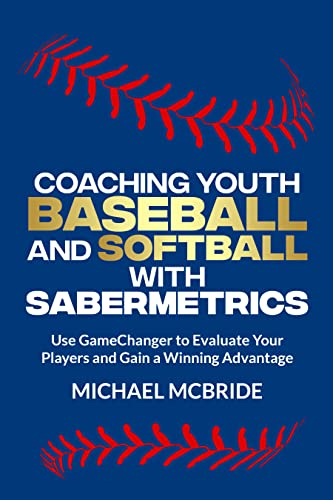Coaching Youth Baseball and Softball with Sabermetrics

Coaching Youth Baseball and Softball with Sabermetrics
- April 3, 2023
- Book by UCI economics professor Michael McBride breaks down applied sabermetrics in an easy-to-use, no-math-required guide for assessing, developing and advancing youth players and teams
 UCI economist Michael McBride, an avid baseball fan, self-described sabermetrics nerd,
and coach of many of his kids' baseball and softball teams, has launched a new book
series for coaches looking to level up their Little League, Pony and youth teams.
Coaching Youth Baseball and Softball with Sabermetrics (free Kindle version available through Friday, April 7) combines McBride's expertise
as an experimental economist and game theorist with lessons learned on the playing
field to provide a step-by-step guide on how to use readily available data in team
scorekeeping apps to assess and develop players’ skill sets, devise ideal batting
lineups, and more. Below, McBride shares more about his work and where interested
readers can pick up the first book in the series.
UCI economist Michael McBride, an avid baseball fan, self-described sabermetrics nerd,
and coach of many of his kids' baseball and softball teams, has launched a new book
series for coaches looking to level up their Little League, Pony and youth teams.
Coaching Youth Baseball and Softball with Sabermetrics (free Kindle version available through Friday, April 7) combines McBride's expertise
as an experimental economist and game theorist with lessons learned on the playing
field to provide a step-by-step guide on how to use readily available data in team
scorekeeping apps to assess and develop players’ skill sets, devise ideal batting
lineups, and more. Below, McBride shares more about his work and where interested
readers can pick up the first book in the series.
Where did the idea for this book come from? How do your research interests and expertise as an economist factor in?
There were three driving factors behind the book. First, several years ago when I was coaching my son’s Little League team, I realized that lesser-known statistics can help me evaluate players’ batting skills more accurately. It was clear that sabermetrics could help me as a coach, and I thought it could help others too. Second, when I first learned of GameChanger, I was blown away that coaches could have all of these statistics right at their fingertips with no extra work. Third, most coaches and parents that I've talked to about sabermetrics have been generally unfamiliar with many sabermetric ideas but very interested in knowing about them. So I knew that there would be an audience for a book like this.
The main way that research expertise comes into the book is that I had to investigate how and to what extent some of the key ideas in sabermetrics for higher levels actually apply at youth levels. As an experimental economist, I have lots of practice thinking carefully about how data are generated and how those processes affect the confidence of the conclusions that you can draw. I also am not afraid of some nitty-gritty data analysis. Although I consider this book to be first and foremost a general service to the youth baseball and softball communities, there are some actual bits of original research sprinkled in here and there if you look for them.
What inspired you to apply sabermetrics to youth baseball and softball coaching?
I am a baseball fan, a sabermetrics nerd, and a parent and frequent coach of kids who have played youth baseball and softball, so it was inevitable that I would apply sabermetrics to their play! I just had to learn that the statistics were readily available.
Can you give a brief explainer on how GameChanger works and how coaches can use already available data to better evaluate their players?
GameChanger is a scorekeeping smart-phone app. The team's official scorekeeper uses the app to record play-by-play details as the game progresses, and the great thing about it is that it automatically calculates dozens of statistics that can be easily accessed and reviewed. There are other scorekeeping apps, but GameChanger is very popular.
Coaches can access the statistics via their phones or through a computer browser. There is simple sorting functionality, so a coach can easily see who has the highest of one stat, the lowest of another, and so on. The data can also be exported into a spreadsheet if the coach wants to do some of their own calculations. Most coaches won't go that far, so my book focuses on evaluating the players via the phone or the browser.
How do you think sabermetrics can improve the overall performance of a youth baseball or softball team?
There are three main ways that sabermetrics can help a team. One way is that it can help a team win games. Sabermetrics can help a coach know how to structure their lineups, when to play aggressively, and so on. Another way is that it helps a coach with developing their players. Sabermetrics can help a coach identify which players need to work on which skills and then tailor individual and team skill development to the areas that are most in need of improvement. A third way is to motivate players. I have seen discouraged players be uplifted by mention of something good that they did because it was measured.
One last thing is that sabermetrics can help a coach construct their team. I’m the head coach of my daughter's softball team right now, and I had to select our team via a draft. I was able to also get statistics for most of the players in the draft and do some sabermetric analysis to determine my draft strategy. I think I did pretty well!
What advice do you have for coaches who are new to using statistical analysis in their coaching strategy? Similarly, how can parents and players use this data to better understand player value beyond traditional box score stats?
Well, get my book, of course! The book offers a large number of tips that coaches can follow, but I know that it's a lot for a coach to consider all of them. So before going into all of the details of those tips, I list a few first steps that a coach can take to get started. Specifically, there are a handful of key statistics that are the first ones a coach should look at. Beyond that, a coach should keep an open mind, realizing that the book shares ideas that complement -- not replace -- what they already know about good coaching.
My advice is the same for parents: get the book! Many statistics are insightful, but some are not -- or at least they do not provide the insights that the parent might think they are providing. I have seen parents evaluate their own child using the wrong statistics. I've also seen parents misinterpret statistics. So even though the book's primary audience is coaches, parents can benefit from the book, too, because it will help them to better understand what the statistics are actually telling them.
As the first book in the series, can you give some insight on what the next book looks like, and how readers can get notified of its release?
This first book is about evaluating youth baseball and softball players, which is something that a coach will do primarily outside of games and practices when they have the opportunity to look at the statistics. You can get the book now on Amazon. The next book is about making informed strategic decisions during a game, like about sacrifice bunts, base stealing, pitcher substitutions, defensive positioning, and so on. Of course, an accurate assessment of your players and their skills will help with your in-game strategy decisions, so these first two books fit together nicely.
The easiest way to get more information is to send an email to YouthSabermetrics@gmail.com and tell me you want to be notified about the next book. But you can also visit my UCI website. This has information about the first book now, and I will post information about the next book closer to the release date.
Michael McBride is a professor of economics and director of the Experimental Social Science Laboratory at UCI. His research uses game theory and experimental methods to investigate sources of conflict and cooperation. In 2020, he presented his sabermetrics work on how to accurately credit player contributions to a team’s win at the famed Society for American Baseball Research (SABR) Analytics Conference. It’s currently under review for publication. Hear more from McBride in this Experts On video feature.
Would you like to get more involved with the social sciences? Email us at communications@socsci.uci.edu to connect.
Share on:
Related News Items
- A cash-for-clunkers program could reduce aviation emissions
- Coaching Youth Baseball and Softball with Sabermetrics: Strategies to Improve Your In-game Decisions and Gain a Competitive Edge
- Saddleback Church loses appeal over ouster from Southern Baptist Convention
- Flannery Fired Up: Baseball (video)
- UCI Experts On: Baseball statistics




connect with us